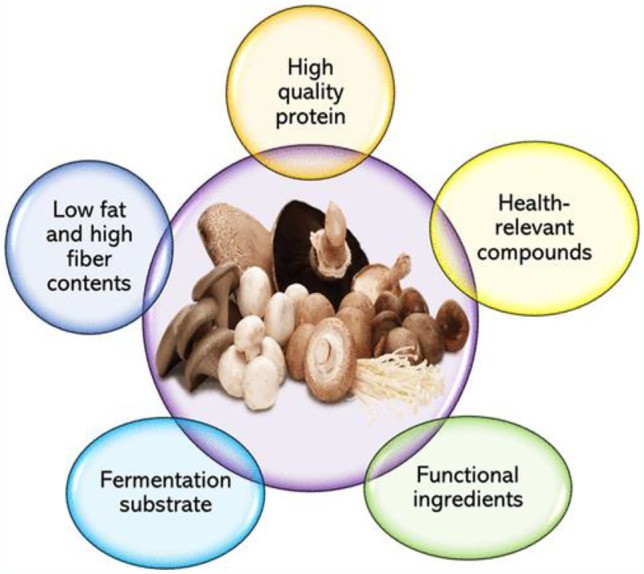The increasing global population, evolving economies, shifting dietary habits, and health concerns have spurred the search for cost-effective protein alternatives to animal sources. The question, “Are Mushrooms A Protein Food?”, is becoming increasingly relevant. This article explores the potential of mushroom protein as a viable future protein source, examining its nutritional value, quality, digestibility, and biological benefits.
Plant-based proteins are often touted as alternatives to animal proteins. However, many lack essential amino acids. Edible mushrooms, on the other hand, typically possess a complete essential amino acid profile, fulfilling dietary requirements and offering economic advantages over both animal and plant sources. Moreover, mushroom proteins may offer health benefits, exhibiting antioxidant, antitumor, angiotensin-converting enzyme (ACE) inhibitory, and antimicrobial properties, potentially surpassing those of animal proteins. Mushroom protein concentrates, hydrolysates, and peptides are increasingly utilized to enhance human health. Furthermore, edible mushrooms can fortify traditional foods, boosting their protein value and functional qualities. These attributes underscore mushroom proteins as an affordable, high-quality protein source suitable as a meat alternative, a pharmaceutical ingredient, and a means to combat malnutrition.
The Nutritional Value of Mushroom Protein
Before considering mushrooms a viable protein alternative, their availability and protein content must be assessed. In 2018, global cultivated mushroom production reached approximately 9 million tons, according to the United Nations’ Food and Agriculture Organization. The most commonly farmed species include Agaricus bisporus (white button mushroom), Lentinula edodes (shiitake), Pleurotus ostreatus (oyster mushroom), and Flammulina velutipes (golden needle mushroom). Agaricus bisporus is the most widely consumed mushroom globally, followed by Pleurotus spp. and Lentinus edodes. Numerous other edible mushrooms with high protein values are also cultivated worldwide.
The human body requires ample protein for growth, maintenance, and physiological functions like hormone and enzyme production. Although mushroom protein content varies based on species, strain, maturity, cultivation substrate, and environmental factors, mushrooms offer significant protein at a lower cost than many plant and animal sources.
Protein constitutes approximately 17% of total calorie consumption. Numerous studies have revealed that mushrooms are particularly rich in crude protein. Edible mushrooms contain protein ranging from 6.60 to 36.87 g/100 g, with an average of 23.80 g/100 g dry weight. Tricholoma species exhibit the highest protein content, while Laetiporus sulphureus and Polyporus dictyopus show the lowest. Popular edible mushroom species like Lentinus edodes, Agaricus spp., and Pleurotus spp. contain 14.87 to 27.13%, 26.60 to 39.84%, and 18 to 19.15 g/100 g of protein, respectively. Interestingly, different parts of the mushroom can have varying protein levels. Nutritional analysis of South African mushrooms revealed protein values ranging from 18% (L. deliciosus) to 37.0% (B. edulis), with the pileus (cap) being richer in protein.
The nutritional value of mushroom protein is determined by both its quantity and its ability to meet dietary needs, such as the Recommended Dietary Allowance (RDA) and Protein Efficiency Ratio (PER). Certain species, like Tricholoma, Copyinds, Volvariella, Termitomyces, Lentinus, and Agaricus, exhibit high protein values (25-40%). Notably, 100 g of these mushrooms can provide between 29.41 and 66.0% of the RDA for men and between 35.80 and 80.35% of the RDA for women. Data indicates that Pleurotus ostreatus (black oyster) has the highest PER of any mushroom, even surpassing beef jerky. Several edible mushrooms can provide protein values comparable to or even higher than animal sources like milk, eggs, meat, and fish, as well as high-protein plant-based sources. Thus, edible mushrooms are an excellent source of high-quality protein that can be produced more easily, affordably, and with less environmental impact.
Quality and Digestibility of Mushroom Proteins
Beyond protein quantity, the quality of mushroom protein lies in its ability to provide essential amino acids necessary for growth and bodily functions. Protein-containing food scoring systems effectively compare the quality of protein sources.
The Essential Amino Acid Score (EAAS), also known as the chemical score, compares the proportion of each essential amino acid in a test protein to a reference standard. Various studies show that several Agaricus spp., Pleurotus spp. and Letinus edodes exhibit high amounts of quality protein, particularly Agaricus spp., Pleurotus spp. and Letinus edodes. Furthermore, some varieties of Pleurotus and other mushrooms have a complete range of amino acids and amino acid scores comparable to the WHO standard. The quality of the amino acid profile is determined by the combination of free and bound amino acids (AA). Various studies confirm that select mushrooms have high levels of essential free and bound amino acids and chemical scores comparable to top plant sources.
Protein digestibility is crucial for estimating protein nutritional quality. The Protein Digestibility Corrected Amino Acid Score (PDCAAS) assesses protein quality by considering both human amino acid needs and digestive capabilities. PDCAAS values for mushrooms range from 0.35 to 0.70 based on in vitro and in vivo digestibility studies. When compared to other protein sources some mushrooms outperformed oilseeds, fruits and cereals but lower than meat and dairy. However, using mushrooms at twice the weight of meat and dairy could result in a score equivalent to or higher than these animal proteins. Also, the Biological Value (BV) score of mushrooms (80) is at par with milk (100) and meat (80–85), and higher than cereal (40–45) and legume (50–55).
The digestibility of mushroom protein can be affected by anti-nutritional factors like phenolics, phytates, and tannins, although their levels are generally below WHO toxicity limits. The processing of mushroom proteins can also impact digestibility. Overall, mushroom protein digestibility is excellent, supporting PDCAAS and BV ratings. This makes edible mushrooms an important part of human nutrition.
The Biological Role of Mushroom Proteins in the Diet
Mushrooms are consumed as a source of protein in meals and food preparations. High protein digestion is essential in releasing amino acids to support host physiology, while unhydrolyzed protein can improve health by stimulating the gut microbiota. Additionally, edible mushrooms have been recently used for food fortification or enrichment. Incorporating mushrooms into food products increases nutritional value, particularly protein, as shown by numerous studies, where the addition of mushroom powder increased the protein content significantly.
Furthermore, plant and mushroom-based foods that are nutritious, delicious, and high in protein are gaining popularity as meat substitutes. Mushrooms enhance the organoleptic or sensory qualities of processed foods, such as meat substitutes. They are fibrous, which makes meat analogues more chewable, and offer a taste similar to meat, improving palatability.
The Future of Mushroom Protein
Edible mushrooms and their proteins have the potential to be extensively involved in a variety of areas with diverse applications in the future. By 2050, 9.2 billion people are expected to live on earth and consume twice as many resources as today. By using mushrooms as the source of protein, this can combat food insecurity and malnutrition, and be used as a meat substitute. Furthermore, mushroom proteins are future high-quality protein substitutes that are easily accessible to both wealthy and underprivileged populations.
In conclusion, edible mushrooms are a valuable source of protein for both food and medicine. They contain more protein than vegetables, fruits, and grains and are safer than meat proteins. Furthermore, mushroom protein is of high quality, with complete essential amino acids and excellent digestibility. These qualities make mushrooms an excellent source of protein.

